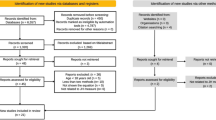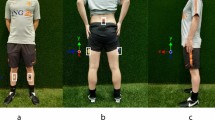Abstract
Purpose The objective of this study was to determine the agreement of kinematic parameters calculated from motion data collected via a 2D video-based pose-estimation (markerless motion capture) approach and a laboratory-based 3D motion capture approach during a floor-to-waist height functional lifting test. Method Twenty healthy participants each performed three floor-to-waist height lifts. Participants’ lifts were captured simultaneously using 2D video (camcorder) in the sagittal plane and 3D motion capture (Vicon, Oxford, UK). The three lifts were representative of a perceived light, medium, and heavy load. Post-collection, video data were processed through a pose-estimation software (i.e., markerless motion capture). Motion data from 3D motion capture and video-based markerless motion capture were each used to calculate objective measures of interest relevant to a functional capacity evaluation (i.e., posture, balance, distance of the load from the body, and coordination). Bland–Altman analyses were used to calculate agreement between the two methods. Results Bland–Altman analysis revealed that mean differences ranged from 1.9° to 22.1° for posture and coordination-based metrics calculated using markerless and 3D motion capture, respectively. Limits of agreement for most posture and coordination measures were approximately + 20°. Conclusions 2D video-based pose estimation offers a strategy to objectively measure movement and subsequently calculated metrics of interest within an FCE context and setting, but at present the agreement between metrics calculated using 2D video-based methods and 3D motion capture is insufficient. Therefore, continued effort is required to improve the accuracy of 2D-video based pose estimation prior to inclusion into functional testing paradigms.





Similar content being viewed by others
Abbreviations
- FCE:
-
Functional capacity evaluation
- RTW:
-
Return to work
- BOS:
-
Base of support
- COG:
-
Center of gravity
- MARP:
-
Mean absolute relative phase
- CRP:
-
Continuous relative phase
- MMH:
-
Manual materials handling
- ASIS:
-
Anterior superior iliac spine
- SI:
-
Superior inferior
- AP:
-
Anterior posterior
- ML:
-
Medial lateral
- CBOS:
-
Center of base of support
- FSL:
-
Functional stability limit
- B–A:
-
Bland–Altman
References
King PM, Tuckwell N, Bawett TE. A critical review of functional capacity evaluations. Phys Ther. 1998;78(8):852–866.
Sinden KE, McGillivary TL, Chapman E, Fischer SL. Survey of kinesiologists’ functional capacity evaluation practice in Canada. Work. 2017;56(4):571–580.
Dempsey PG. A critical review of biomechanical, epidemiological, physiological and psychophysical criteria for designing manual materials handling tasks. Ergonomics. 1998;41(1):73–88.
Tengland PA. The concept of work ability. J Occup Rehabil. 2011;21:275–285.
Harbin G, Olson J. Post-offer, pre-placement testing in industry. Am J Ind Med. 2005;47(4):296–307.
Innes E. Reliability and validity of functional capacity evaluations: an update. Int J Disabil Manag. 2006;1(1):135–148.
Trippolini MA, Dijkstra PU, Jansen B, Oesch P, Geertzen JHB, Reneman MF. Reliability of clinician rated physical effort determination during functional capacity evaluation in patients with chronic musculoskeletal pain. J Occup Med Toxicol. 2014;24:361–369.
Allison S, Galper J, Hoyle D, Mecham J. Current concepts in functional capacity evaluation: a best practices guideline. 2018. https://www.orthopt.org/uploads/content_files/files/2018%20Current%20Concepts%20in%20OH%20PT-FCE%2006-20-18%20FINAL.pdf.
Reneman MF, Fokkens AS, Dijkstra PU, Geertzen JHB, Groothoff JW. Testing lifting capacity: validity of determining effort level by means of observation. Spine. 2005;30(2):40–46.
Smith RL. Therapists’ ability to identify safe maximum lifting in low back pain patients during functional capacity evaluation. J Orthop Sports Phys Ther. 1994;19(5):277–281.
Cao Z, Hidalgo Martinez G, Simon T, Wei SE, Sheikh YA. OpenPose: realtime multi-person 2D pose estimation using part affinity fields. IEEE Trans Pattern Anal Mach Intell. 2019;43(1):172–186.
McKinnon CD, Sonne MW, Keir PJ. Assessment of joint angle and reach envelope demands using a video—based physical demands description tool. Hum Factors. 2020. https://doi.org/10.1177/0018720820951349.
Armstrong DP, Budarick AR, Pegg CEE, Graham RB, Fischer SL. Feature detection and biomechanical analysis to objectively identify high exposure movement strategies when performing the EPIC lift capacity test. J Occup Rehab. 2021;31:50–62.
Holbein MA, Redfern MS. Functional stability limits while holding loads in various positions. Int J Ind Ergon. 1997;19(5):387–395.
Armstrong DP, Ross GB, Graham RB, Fischer SL. Considering movement competency within physical employment standards. Work. 2019;63(4):603–613.
Trafimow J, Aruin AS. The use of negative acceleration as accessory force during lifting. Adv Orthop. 2018. https://doi.org/10.1155/2018/9164590.
Burgess-Limerick R, Abernethy B, Neal RJ. Relative phase quantifies interjoint coordination. J Biomech. 1993;26(1):91–94.
Galgon AK, Shewokis PA. Using mean absolute relative phase, deviation phase and point-estimation relative phase to measure postural coordination in a serial reaching task. J Sports Sci Med. 2016;15:131–141.
Lowe BD, Weir P, Andrews D. Observation-based posture assessment: review of current practice and recommendations for improvement; 2014.
Waters TR, Putz-Anderson V, Garg A, Fine LJ. Revised NIOSH equation for the design and evaluation of manual lifting tasks. Ergonomics. 1993;36(7):749–776.
Sheppard PS, Stevenson JM, Graham RB. Sex-based differences in lifting technique under increasing load conditions: a principal component analysis. Appl Ergon. 2016;54:186–195.
Liao JJZ. Sample size calculation for an agreement study. Pharm Stat. 2020;132:125–132.
Howarth SJ, Callaghan JP. Quantitative assessment of the accuracy for three interpolation techniques in kinematic analysis of human movement Quantitative assessment of the accuracy for three interpolation techniques in kinematic analysis of human movement. Comput Methods Biomech Biomed Eng. 2010;13(6):847–855.
Wu G, Siegler S, Allard P, Kirtley C, Leardini A, Rosenbaum D, Whittle M, D’Lima DD, Cristofolini L, Witte H, Schmid O. ISB recommendation on definitions of joint coordinate system of various joints for the reporting of human joint motion—part I: ankle, hip, and spine. J Biomech. 2002;35(4):543–548.
Wu G, Van der Helm FC, Veeger HD, Makhsous M, Van Roy P, Anglin C, Nagels J, Karduna AR, McQuade K, Wang X, Werner FW. ISB recommendation on definitions of joint coordinate systems of various joints for the reporting of human joint motion—Part II: shoulder, elbow, wrist and hand. J Biomech. 2005;38(5):981–992.
Nussbaum MA, Zhang X. Heuristics for locating upper extremity joint centres from a reduced set of surface markers. Hum Mov Sci. 2000;19(5):797–816.
Bell AL, Brand RA, Pedersen DR. Prediction of hip joint centre location from external landmarks. Hum Mov Sci. 1989;8(1):3–16.
Bell AL, Pedersen DR, Brand RA. A comparison of the accuracy of several hip center location prediction methods. J Biomech. 1989;23(6):617–621.
Winter DA. Biomechanics and motor control of human movement. New York: Wiley; 2009.
Robertson DGE, Caldwell GE, Hamill J. Research methods in biomechanics. 2nd ed. Publisher; 2014.
Drillis R, Contini R. Body segment parameters. New York: Office of Vocational Rehabilitation, (Report No.: No. 1166-03.). 1966.
Holbein-Jenny MA, McDermott K, Shaw C, Demchak J. Validity of functional stability limits as a measure of balance in adults aged 23–73 years. Ergonomics. 2007;50(5):631–646.
Lamb PF, Stöckl M. On the use of continuous relative phase: review of current approaches and outline for a new standard. Clin Biomech. 2014;29(5):484–493.
Albert WJ, Wrigley AT, McLean RB. Are males and females similarly consistent in their respective lifting patterns? Theor Issues Ergon Sci. 2008;9(4):347–358.
Bland JM, Altman DG. Statistical methods for assessing agreement between two methods of clinical measurement. The Lancet. 1986;327(8476):307–310.
Keogh JWL, Cox A, Anderson S, Liew B, Olsen A, Schram B, Furness J. Reliability and validity of clinically accessible smartphone applications to measure joint range of motion: a systematic review. PLoS ONE. 2019;14(5):1–24.
Walfish S. A review of statistical outlier methods. Pharm Technol. 2006;30(11):82.
Schurr SA, Marshall AN, Resch JE, Saliba SA. Two-dimensional video analysis is comparable to 3D motion capture in lower extremity movement assessment. Int J Sports Phys Ther. 2017;12(2):163–172.
Pfister A, West AM, Bronner S, Noah JA. Comparative abilities of Microsoft Kinect and Vicon 3D motion capture for gait analysis. J Med Eng Technol. 2014;38(5):274–280.
Mentiplay BF, Perraton LG, Bower KJ, Pua YH, McGaw R, Heywood S, Clark RA. Gait assessment using the Microsoft Xbox One Kinect: concurrent validity and inter-day reliability of spatiotemporal and kinematic variables. J Biomech. 2015;48(10):2166–2170.
Clark RA, Pua YH, Fortin K, Ritchie C, Webster KE, Denehy L, Bryant AL. Validity of the Microsoft Kinect for assessment of postural control. Gait Posture. 2012;36(3):372–377.
Funding
This study was supported by an Ontario Early Career Award (ER16-12-163) held by S. Fischer. S. Remedios received partial support via the Employers' Advocacy Council, Occupational Health and Safety Research Scholarship.
Author information
Authors and Affiliations
Contributions
All authors contributed to the study conception, design and data analysis. Data collection was performed by Sarah M. Remedios. All authors contributed to drafting of the manuscript. All authors read and approved the final manuscript.
Corresponding author
Ethics declarations
Conflict of interest
Sarah M. Remedios and Steven L. Fischer declare that they have no conflict of interest.
Consent to Participate
All participants provided written informed consent prior to participation.
Ethics approval
This study was approved by the University’s Institutional Ethics Board.
Informed Consent
All procedures followed were in accordance with the ethical standards of the responsible committee on human experimentation (institutional and national) and with the Helinski Declaration of 1975, as revised in 2000(5). Informed consent was obtained from all patients for being included in the study.
Additional information
Publisher's Note
Springer Nature remains neutral with regard to jurisdictional claims in published maps and institutional affiliations.
Rights and permissions
About this article
Cite this article
Remedios, S.M., Fischer, S.L. Towards the Use of 2D Video-Based Markerless Motion Capture to Measure and Parameterize Movement During Functional Capacity Evaluation. J Occup Rehabil 31, 754–767 (2021). https://doi.org/10.1007/s10926-021-10002-x
Accepted:
Published:
Issue Date:
DOI: https://doi.org/10.1007/s10926-021-10002-x




